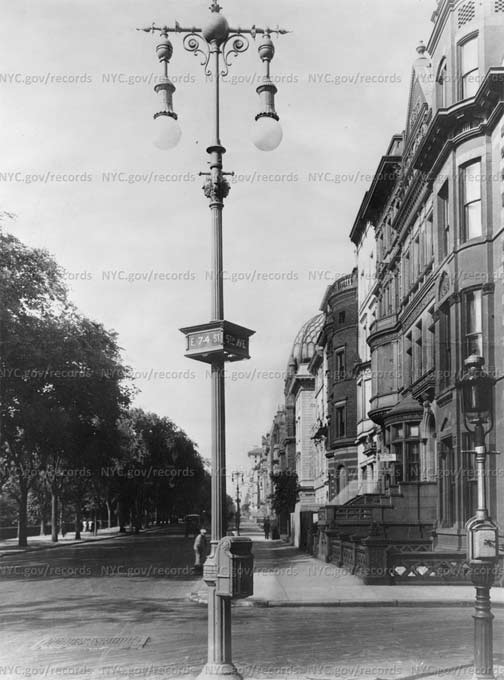Here’s an original Twin lamppost from 5th Avenue’s original batch, first installed two to each intersection in the early 1890s. This original design was used exclusively on 5th Avenue but then found its way to several other streets. In ensuing decades this design would largely be supplanted by a somewhat more streamlined design that still featured plenty of metal scrollwork.
Only one example of this original design can still be found, at the northeast corner of 23rd Street and Broadway at Madison Square. And even that is a hybrid, as the Twin top has been placed on a Type 1 Bishop Crook post (still, the oldest Bishop Crook design).
Note the small affixed slot mailbox on the base, and the ladder rest crossbar, a design atavism that looks back on the gaslit posts of previous decades.
The fire alarm on the right is a design that first appeared in 1903. At the top is an illuminated light featuring red-colored glass.
The street signs mounted on the lamppost were something new in the 1890s, as previously, street signs were affixed to buildings. Manhattan’s familiar humpback street signs first appeared in the mid-1910s.
I don’t have to credit the photo, as the city has made pretty sure who owns it.

About 120 years later this is 5th Avenue and East 74th, looking north. The Queen Anne-style brownstones were long ago replaced by a high rise apartment building. Look closely, though, and you’ll see that the corner still has a fire alarm (the red-colored shaft above the white car).
What will this look like in 150 years? My bet’s on it being under water, but I won’t be around.
6/7/14


2 comments
Were the street signs supposed to be mounted diagonally like that?
The ladder rests were used by the arc lamp “trimmers”to replace (“trim”) the used carbon rods. The luminaires in the photo are of the enclosed carbon arc type. The carbons had a life of from 80 to 100 hours(about ten nights of burning). This may seem a short time,but when you consider that the original open carbon arc luminaires only burned 8 to 10 hours before requiring trimming,it was a great improvement. It can be seen why the arc lamps rapidly became obsolete when the gas filled tungsten incandescent lamp was introduced about 1913. The lamp life was about 1000 hours,requiring only 4 to 5 lamp replacements annually.